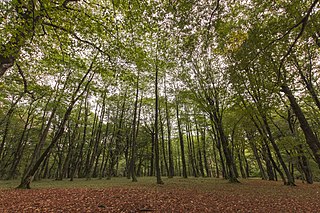
Zelkova is a genus of six species of deciduous trees in the elm family Ulmaceae, native to southern Europe, and southwest and eastern Asia. They vary in size from shrubs to large trees up to 35 m (115 ft) tall. The bark is smooth, dark brown. Unlike the elms, the branchlets are never corky or winged. The leaves are alternate, with serrated margins, and a symmetrical base to the leaf blade. The leaves are in two distinct rows; they have pinnate venation and each vein extends to the leaf margin, where it terminates in a tooth. There are two stipules at each node, though these are caducous, leaving a pair of scars at the leaf base. Zelkova is polygamous. Staminate flowers are clustered in the lower leaf axils of young branchlets; the perianth is campanulate, with four to six lobes, and the stamens are short. Pistillate and hermaphrodite flowers are solitary, or rarely in clusters of two to four, in the upper leaf axils of young branchlets. The fruit is a dry, nut-like drupe with a dorsal keel, produced singly in the leaf axils. The perianth and stigma are persistent.

Zelkova carpinifolia, known as Caucasian zelkova, Caucasian elm or just zelkova, is a species of Zelkova, native to the Caucasus, Kaçkar, and Alborz mountains in the extreme southeast of Europe and southwest Asia.

The Field Elm cultivar Ulmus minor 'Propendens', described by Schneider in 1904 as U. glabra (:minor) var. suberosa propendens, Weeping Cork-barked elm, was said by Krüssmann (1976) to be synonymous with the U. suberosa pendula listed by Lavallée without description in 1877. Earlier still, Loudon's Arboretum et Fruticetum Britannicum had included an illustration of a pendulous "cork-barked field elm", U. campestris suberosa. An U. campestris suberosa pendula was in nurseries by the 1870s.

The elm cultivar Ulmus 'Koopmannii' was cloned from a specimen raised from seed sent from Margilan, Turkestan by Koopmann to the Botanischer Garten Berlin c. 1880. Noted in 1881 as a 'new elm', it was later listed by the Späth nursery, catalogue no. 62, p. 6. 101, 1885, as Ulmus Koopmannii, and later by Krüssmann in 1962 as a cultivar of U. minor. Margilan is beyond the main range of Ulmus minor. Augustine Henry, who saw the specimens in Berlin and Kew, believed Koopmann's Elm to be a form of Ulmus pumila, a view not shared by Rehder of the Arbold Arboretum. Ascherson & Graebner said the tree produced 'very numerous root shoots', which suggests it may be a cultivar of U. minor. Until DNA analysis can confirm its origin, the cultivar is now treated as Ulmus 'Koopmannii'.

The Field Elm cultivar Ulmus minor 'Umbraculifera Gracilis' was obtained as a sport of 'Umbraculifera' by the Späth nursery of Berlin c.1897. It was marketed by the Späth nursery in the early 20th century, and by the Hesse Nursery of Weener, Germany, in the 1930s.
The Field Elm cultivar Ulmus minor 'Microphylla Pendula', the Weeping small-leaved elm, was first listed by the Travemünde nursery, Lübeck, and described by Kirchner in Petzold & Kirchner's Arboretum Muscaviense (1864), as Ulmus microphylla pendulaHort.. By the 1870s it was being marketed in nurseries in Europe and America as Ulmus campestris var. microphylla pendula.
Beauprea congesta is a species of plant in the family Proteaceae. It is endemic to New Caledonia.
Beauprea crassifolia is a species of plant in the family Proteaceae. It is endemic to New Caledonia.

Helicia is a genus of 110 species of trees and shrubs, constituting part of the plant family Proteaceae. They grow naturally in rainforests throughout tropical South and Southeast Asia, including India, Sri Lanka, Indochina, Peninsular Malaysia to New Guinea and as far south as New South Wales.
Helicia albiflora is a species of plant in the family Proteaceae. It is endemic to Papua New Guinea. It is threatened by habitat loss.
Helicia amplifolia is a species of plant in the family Proteaceae. It is endemic to Papua New Guinea. It is threatened by habitat loss.
Helicia insularis is a species of plant in the family Proteaceae. It is endemic to Papua New Guinea. It is threatened by habitat loss.
Helicia neglecta is a species of plant in the family Proteaceae. It is endemic to Papua New Guinea. It is threatened by habitat loss.
Heliciopsis rufidula is a species of plant in the family Proteaceae. It is a tree found in Peninsular Malaysia and Borneo. It is threatened by habitat loss.
Heliciopsis whitmorei is a species of plant in the family Proteaceae. It is a tree endemic to Peninsular Malaysia. It is threatened by habitat loss.
Leucadendron nobile is a species of plant in the family Proteaceae. It is endemic to South Africa.
Roupala pinnata is a species of plant in the family Proteaceae. It is endemic to Peru.

Ostrya carpinifolia, the European hop-hornbeam, is a tree in the family Betulaceae. It is the only species of the genus Ostrya that is native to Europe.
The hybrid elm Ulmus davidianavar.japonica × U. minor was raised at the Arnold Arboretum before 1924.

Ajameti Managed Reserve is a protected area in the Baghdati Municipality, Zestafoni Municipality region of Georgia. It protects famous oaks of Ajameti and other local flora. Some of the trees are from 120 to 200 years old. Reserve also protects local fauna.








